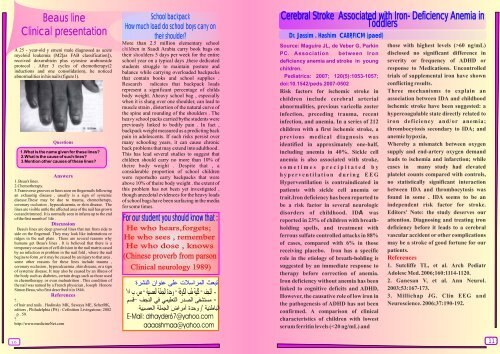Al-Najaf Medical BULLETIN - University of Kufa
Al-Najaf Medical BULLETIN - University of Kufa
Al-Najaf Medical BULLETIN - University of Kufa
Create successful ePaper yourself
Turn your PDF publications into a flip-book with our unique Google optimized e-Paper software.
Beaus line<br />
Clinical presentation<br />
A 25 - year-old y emeni male diagnosed as acute<br />
myeloid leukemia (M2[as FAB classification]),<br />
received doxorubicin plus cytosine arabinoside<br />
protocol . After 3 cycles <strong>of</strong> chemotherapy(2<br />
inductions and one consolidation), he noticed<br />
abnormalities in his nails (figure1).<br />
1.What is the name given for these lines?<br />
2.What is the cause <strong>of</strong> such lines?<br />
3.Mention other causes <strong>of</strong> these lines?<br />
Answers<br />
1. Beau's lines.<br />
2.Chemotherapy.<br />
3.Transverse grooves or lines seen on fingernails following<br />
an exhaustig disease , usually is a sign <strong>of</strong> systemic<br />
disease.These may be due to trauma, chemotherapy,<br />
coronary occlusion , hypocalcaemia, or skin disease. The<br />
lines are visible untle the affected area <strong>of</strong> the nail has grown<br />
out and trimmed . It is normally seen in infants up to the end<br />
<strong>of</strong> the first month <strong>of</strong> life .<br />
Beau's lines are deep grooved lines that run from side to<br />
side on the fingernail. They may look like indentations or<br />
ridges in the nail plate . There are several reasons why<br />
humans get Beau's lines . It is believed that there is a<br />
temporary cessation <strong>of</strong> cell division in the nail matrix cased<br />
by an infection or problem in the nail fold , where the nail<br />
begins to form ,or it may be caused by an injury to that area .<br />
some other reasons for these lines include trauma ,<br />
coronary occlusion , hypocalcaemia , skin disease, or a sign<br />
<strong>of</strong> systemic disease. It may also be caused by an illness <strong>of</strong><br />
the body such as diabetes, certain drugs such as those used<br />
in chemotherapy, or even malnutrition . This condition <strong>of</strong><br />
the nail was named by a French physician , Joseph Honore<br />
Simon Beau, who first described it in 1846.<br />
?.<br />
<strong>of</strong> hair and nails . Hodinsky MK, Sawaya ME, ScherRK,<br />
editors , Philadelphia (PA) : Cefinition Livingstone; 2002<br />
. p . 59.<br />
?.<br />
http://www.medicineNet.com<br />
10<br />
Questions<br />
Discussion<br />
References<br />
School backpack<br />
How much load do school boys carry on<br />
their shoulder?<br />
More than 2.5 million elementary school<br />
children in Saudi Arabia carry book bags on<br />
their shoulders 5 days per week for the entire<br />
school year on a typical days ,these dedicated<br />
students struggle to maintain posture and<br />
balance while carrying overloaded backpacks<br />
that contain books and school supplies .<br />
Research ndicates that backpack loads<br />
represent a significant percentage <strong>of</strong> childs<br />
body weight. Aheavy school bag , especially<br />
when it is slung over one shoulder, can lead to<br />
muscle strain , distortion <strong>of</strong> the natural curve <strong>of</strong><br />
the spine and rounding <strong>of</strong> the shoulders . The<br />
heavy school packs carried bythe students were<br />
previously linked to bodily pain . In fact ,<br />
backpack weight measured as a predicting back<br />
pain in adolescents. If such risks persist over<br />
many schooling years, it can cause chronic<br />
back problems that may extend into adulthood .<br />
This has lead several studies to suggest that<br />
children should carry no more than 10% <strong>of</strong><br />
theire body weight . Despite that , a<br />
considerable proportion <strong>of</strong> school children<br />
were reportedto carry backpacks that were<br />
above 10% <strong>of</strong> theire body weight . the extent <strong>of</strong><br />
this problem has not been yet investigated ,<br />
though anecdotal evidences for the heavy loads<br />
<strong>of</strong> school bags have been surfacing in the media<br />
for some times.<br />
For our student you should know that :<br />
He who hears,forgets;<br />
He who sees , remember<br />
He who dose , knows<br />
(Chinese proverb from parson<br />
Clinical neurology 1989)<br />
-<br />
-<br />
Cerebral Stroke Associated with Iron- Deficiency Anemia in<br />
Toddlers<br />
Dr. Jassim . Hashim CABP,FICM (paed)<br />
Source: Maguire JL, de Veber G, Parkin<br />
PC. Association between Iron<br />
deficiency anemia and stroke in young<br />
children.<br />
Pediatrics: 2007; 120(5):1053-1057;<br />
doi:10.1542/peds.2007-0502<br />
Risk factors for ischemic stroke in<br />
children include cerebral arterial<br />
abnormalities, previous varicella zoster<br />
infection, preceding trauma, recent<br />
infection, and anemia. In a series <strong>of</strong> 212<br />
children with a first ischemic stroke, a<br />
previous medical diagnosis was<br />
identified in approximately one-half,<br />
including anemia in 40%. Sickle cell<br />
anemia is also associated with stroke,<br />
s o m e t i m e s p r e c i p i t a t e d b y<br />
h y p e r v e n t i l a t i o n d u r i n g E E G<br />
Hyperventilation is contraindicated in<br />
patients with sickle cell anemia or<br />
trait.Iron deficiency has been reported to<br />
be a risk factor in several neurologic<br />
disorders <strong>of</strong> childhood. IDA was<br />
reported in 23% <strong>of</strong> children with breathholding<br />
spells, and treatment with<br />
ferrous sulfate controlled attacks in 88%<br />
<strong>of</strong> cases, compared with 6% in those<br />
receiving placebo. Iron has a specific<br />
role in the etiology <strong>of</strong> breath-holding is<br />
suggested by an immediate response to<br />
therapy before correction <strong>of</strong> anemia.<br />
Iron deficiency without anemia has been<br />
linked to cognitive deficits and ADHD,<br />
However, the causative role <strong>of</strong> low iron in<br />
the pathogenesis <strong>of</strong> ADHD has not been<br />
confirmed. A comparison <strong>of</strong> clinical<br />
characteristics <strong>of</strong> children with lowest<br />
serum ferritin levels (60 ng/mL)<br />
disclosed no significant difference in<br />
severity or frequency <strong>of</strong> ADHD or<br />
response to Medications. Uncontrolled<br />
trials <strong>of</strong> supplemental iron have shown<br />
conflicting results.<br />
Three mechanisms to explain an<br />
association between IDA and childhood<br />
ischemic stroke have been suggested: a<br />
hypercoagulable state directly related to<br />
iron deficiency and/or anemia;<br />
thrombocytosis secondary to IDA; and<br />
anemic hypoxia,<br />
Whereby a mismatch between oxygen<br />
supply and end-artery oxygen demand<br />
leads to ischemia and infarction; while<br />
cases in many study had elevated<br />
platelet counts compared with controls,<br />
no statistically significant interaction<br />
between IDA and thrombocytosis was<br />
found in some . IDA seems to be an<br />
independent risk factor for stroke.<br />
Editors' Note: the study deserves our<br />
attention. Diagnosing and treating iron<br />
deficiency before it leads to a cerebral<br />
vascular accident or other complications<br />
may be a stroke <strong>of</strong> good fortune for our<br />
patients.<br />
References<br />
1. Sutcliffe TL, et al. Arch Pediatr<br />
Adolesc Med. 2006;160:1114-1120.<br />
2. Ganesan V, et al. Ann Neurol.<br />
2003;53:167-173.<br />
3. Millichap JG. Clin EEG and<br />
Neuroscience. 2006;37:190-192.<br />
11



